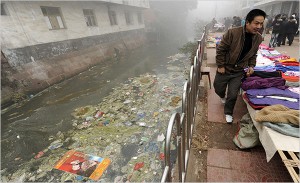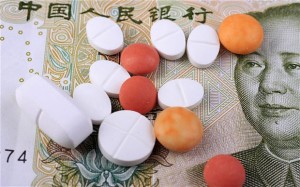Distribution of Resources
FOOD & WATER
China possesses only 6.2% of global freshwater resources to supply 21% of the world’s population.
In 2009 the gross domestic product (GDP) was US$4 985 461 million (Table 1). In 2009, agriculture accounted for around 10 percent of GDP, while in 1999 and 1989 it accounted for 16 percent and 25 percent respectively. The economically active population is about 818 million (2009) of which 54 percent is male and 46 percent female. The agriculture sector employed 503 million inhabitants, 61 percent of the economically active population, of which 52 percent were men and 48 percent women, while in 1998 and 1988, the agriculture sector employed 67 and 72 percent respectively of the economically active population.
China has about 21 percent of the world population, with about 6 percent of the world’s freshwater and 9 percent the world’s farmlands. Per capita freshwater availability was 2 079 m3 in 2009, compared to a global average of 6 225 m3 per capita. To feed the increasing population, China has to increase total agricultural products by almost 30 percent in 2030 (Yuanhua Li, 2006).
Irrigation makes a major contribution to food security, producing nearly 75 percent of the cereals and more than 90 percent of cotton, fruits, vegetables and other agricultural commodities on around half of the farmlands in China. Because of the development of irrigation, food production has kept pace with population growth in recent decades. In the future, as population increases, irrigation would have to play an even more important role in China to increase production, since farmland expansion becomes a limiting factor (Li, 2006).
Northern China, although it has only 20 percent of the nation’s water resources, contains 65 percent of China’s cultivated land and produces roughly half of its grain and nearly all of its wheat and maize. This region accounts for more than 45 percent of the nation’s GDP (Wang et al., 2005).
Drought affects an average of 15.3 million ha of farmland every year, nearly 13 percent of the total farming area (Yao, 2009).
EDUCATION
BEIJING – Evidence of China’s regional development gap can easily be found so far as education is concerned.
Recent media reports stated that 3,000 primary school students in Central China’s Hubeiprovince had to bring their own desks and chairs to school when the new semester began onMonday, with some Internet users posting photos of their shabby classrooms on Sina Weibo, apopular microblogging site. Education facilities in villages near the Dabie Mountains, where the 3,000 children live, arepoor indeed. Some of the region’s teachers don’t even have their own desks. The studentshave become accustomed to bringing their own desks and chairs at the start of eachsemester.
“I think local authorities haven’t paid much attention to education. Instead, they would rather waste money on vanity projects,” wrote Weibo user “shengxiaoxing.” Although the underdeveloped condition of the local economy has been blamed by some, others have questioned the local government’s passion for providing quality education. “If the officials would only spare some of the money they spend on cars and lavish banquets, the children could have desks and chairs,” wrote user “a Beijinger in Beijing” on news portal Sina.com.
Statistics released by the Ministry of Education showed that the number of primary school pupils declined by 143,400 to 99.26 million last month, with a similar drop seen in the number of junior high school students. Although some have cited the statistics as evidence of a surplus of education resources, the imbalance between urban and rural areas is massive, according to Tang Lihong, a professor at Fuzhou University in east China’s Fujian province. Inadequate facilities are not the only problem facing rural educators, who have also had to struggle with a shortage of qualified teachers, as many new teachers refuse to take jobs in far-flung rural areas.
Urban schools also suffer
While shattered windows, broken desks and dirty walls are a sad but common sight in rural schools, similar conditions can also be found in bustling cities. In Sanya, a tourist city in South China’s tropical island province of Hainan, a shabby two-story building contrasts sharply with its surrounding high-end hotels and villas, some of which are located just a stone’s throw from the school. The building is part of a primary school for the children of migrant workers. Photos of the school were posted on popular Internet forum Tianya.cn earlier this year, leading many netizens to express their concern regarding education for the children of migrant workers, a valuable but often marginalized population in China.
Although the government has repeatedly pledged to make efforts to improve education for migrant children, computers and other essential equipment and facilities are still rare or nonexistent in migrant schools, even in developed cities like Beijing. Prof. Tang said long-term, overall planning is needed to ensure that education resources are distributed evenly to all of the country’s children, no matter where they live.
The city government of Macheng, which administers the villages in the Dabie Mountains, said it plans to spend 5 million yuan ($787,415) to purchase desks and chairs for all the primary and junior high schools under its jurisdiction. On August 29, the State Council, or China’s cabinet, approved a string of measures designed to narrow the education gap between urban and rural areas, pledging more investment in rural and poverty-stricken areas. It said promoting balanced and quality education will be a primary task for the nation over the next several years. According to the new measures, qualified teachers and college graduates will be encouraged to go to rural schools in order to eliminate the shortage of qualified teachers there.
HEALTHCARE
Rural-urban inequities, over prescription of drugs by public hospitals, underpaid healthcare professionals and unequal distribution of healthcare resources remained some of the challenges faced by the Chinese Government today. In 2006, President Hu Jintao publicly acknowledged health care as one of the top priorities for a rapidly modernizing China and recently opened the door to foreign investors into Chinese hospitals. The present state of the Chinese health care industry creates unique challenges for companies and market researchers intent on discovering insights to assist with product and brand development in China.
The health care reforms of the 80’s were successful in raising health standards and in turn, life expectancy for millions of rural dwelling Chinese. However, a lack of primary care facilities such as general practitioner clinics has led to chaotic over-crowding and confusion at hospitals. Seriously ill patients are forced to stand in line with patients who have minor ailments. While there are some specialized clinics to cater for women’s health or cancer, many of them are still located on the same premises as the general hospitals and are generally priced beyond the average income of the majority of Chinese citizens. Thus patients in China’s 18,000 plus hospitals are left jostling in queues to consult their doctors.
In Shanghai, where the average salary of doctors is among the highest in the country, doctors are only paid a declared income of RMB 5,000 (US$795) per month. To supplement their incomes, many of them work on commission schemes that pay cash for each test administered and medication prescribed. This has resulted in many unnecessary prescriptions.
While the rich are predominantly well-insured and only need to pay a small percentage of their medical expenses, many of the poor are left with no alternative but to deal with their illnesses outside of hospitals. Currently, urban economic centers such as Shanghai, Beijing and Guangzhou have hospitals which are able to provide excellent doctors and quality equipment. However, this same level of services is understandably not possible across smaller cities and rural areas due to the huge costs involved.








 This is the default footer layout. You can easily add or remove columns in the footer.
This is the default footer layout. You can easily add or remove columns in the footer.
Recent Comments